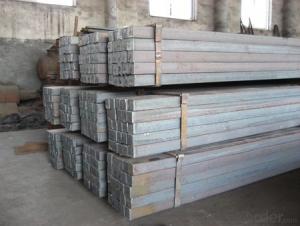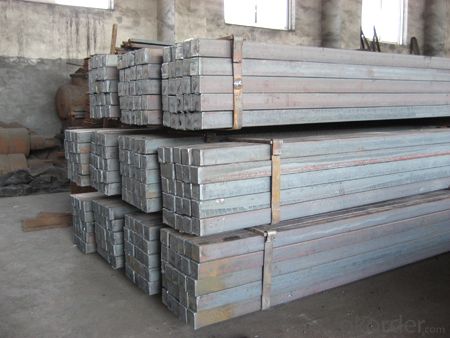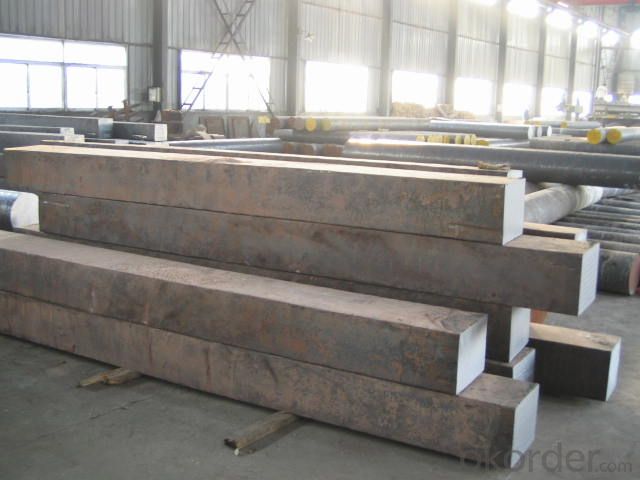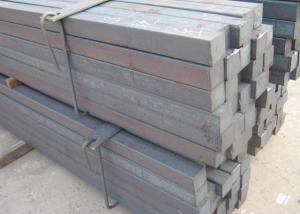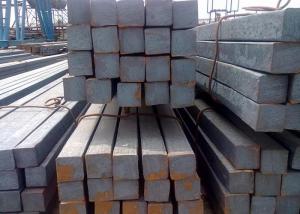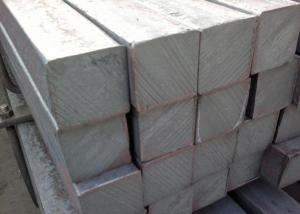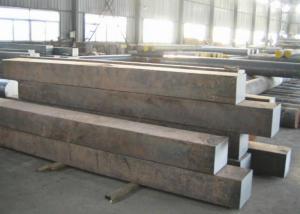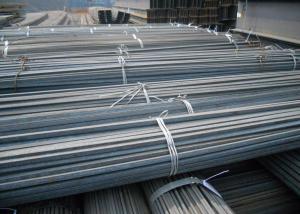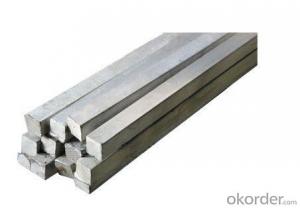High Quality GB Standard Steel Square Bar 63mm-80mm
- Loading Port:
- Tianjin
- Payment Terms:
- TT OR LC
- Min Order Qty:
- 25 m.t
- Supply Capability:
- 10000 m.t/month
OKorder Service Pledge
OKorder Financial Service
You Might Also Like
Product Description:
We offer Square Steel Bar with grade Q195 / Q235
Specifications of Square Steel Bar:
-Standard: GB,
-Grade: Q195/Q235 or equivalent.
Chemical Composition:
-Chemical Composition. Q195
Standard | Grade | Element (%) | ||||
GB | Q195 | C | Mn | S | P | Si |
0.06~0.12 | 0.25~0.50 | ≤0.050 | ≤0.045 | ≤0.30 | ||
-Chemical Composition. Q235
Standard | Grade | Element (%) | ||||
GB | Q235B | C | Mn | S | P | Si |
0.12~0.20 | 0.30~0.70 | ≤0.045 | ≤0.045 | ≤0.30 | ||
Measures and Tolerances of Square Steel Bar:
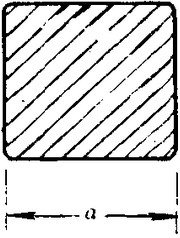
(The section of Square Steel Bar)
-The length of a side and the theoretical weight of Square Steel.
Length of a side(a, mm) | Theoretical weight(kg/m) | Length of a side(a, mm) | Theoretical weight(kg/m) |
6 | 0.283 | 32 | 8.04 |
7 | 0.385 | *33 | 8.55 |
8 | 0.502 | 34 | 9.07 |
9 | 0.636 | *35 | 9.62 |
10 | 0.785 | 36 | 10.17 |
11 | 0.950 | 38 | 11.24 |
12 | 1.13 | 40 | 12.56 |
13 | 1.33 | 42 | 13.85 |
14 | 1.54 | 45 | 15.90 |
15 | 1.77 | 48 | 18.09 |
16 | 2.01 | 50 | 19.63 |
17 | 2.27 | 53 | 22.05 |
18 | 2.54 | *55 | 23.6 |
19 | 2.82 | 56 | 24.61 |
20 | 3.14 | *58 | 26.4 |
21 | 3.46 | 60 | 28.26 |
22 | 3.80 | 63 | 31.16 |
*23 | 4.15 | *65 | 33.17 |
24 | 4.52 | *68 | 36.3 |
25 | 4.91 | 79 | 38.49 |
26 | 5.30 | 75 | 44.16 |
*27 | 5.72 | 80 | 50.24 |
28 | 6.15 | 85 | 56.72 |
*29 | 6.60 | 90 | 63.59 |
30 | 7.06 | 95 | 70.85 |
*31 | 7.54 | 100 | 78.50 |
Notes:
1, The theoretical weights in the list, base on the density of 7.85 g/cm3.
2, The numbers with *mean that they are not regulars or we don’t offer them.
-The allowed tolerance of Square Steel:
Length of a side(mm) | Allowed Tolerance | ||
Group1 | Group2 | Group3 | |
5.5~7 | ±0.20 | ±0.30 | ±0.40 |
7~20 | ±0.25 | ±0.35 | ±0.40 |
20~30 | ±0.30 | ±0.40 | ±0.50 |
30~50 | ±0.40 | ±0.50 | ±0.60 |
60~80 | ±0.60 | ±0.70 | ±0.80 |
80~110 | ±0.90 | ±1.0 | ±1.1 |
110~150 | ±1.2 | ±1.3 | ±1.1 |
150~190 | ―― | ―― | ±2.0 |
190~250 | ―― | ―― | ±2.5 |
Usage/Applications of Steel Square Bar:
-The Square Steel is normally used as structure steel.
-Row material for other structure steel like steel angles, channels, I-beams, H-beams, etc…
Packaging & Delivery of Steel Square Bar:
-Packing Detail: The products can be packed in bundles by steel wires.
-Marks:
1, Tag marks: the tag marks will be tied up to each bundle of the products. The information is usually including supplier’s logo and name, product name, made in China, products’ specifications, the painted color and other information requested by customers.
2, Color marks: we will paint both ends of the bundles of these products to make sure that they are more evident. It’s will be more convenient for the customers to distinguish them at the destination port.
-Delivery Detail: 30~45 working days after receive buyer’s T.T. or L/C.
Transportation:
-The products can be delivered by bulk vessel or by container. As for container, products with the length of 6m will be loaded in 20’ container, with 9m or 12m, in 40’ container.
-The maximum quantity of loading of container is 25 tons.
-The products usually are transported to the nearest port from the production place.
- Q: How do you use a steel square to create scarf joints?
- To use a steel square to create scarf joints, you will need to follow a few steps. First, determine the angle at which you want the joint to be cut. This can be done by measuring the desired angle with a protractor or by using the angles marked on the steel square itself. Once you have determined the angle, place the steel square on the edge of the wood piece that you want to cut. Make sure that the square is aligned with the edge and the angle you have chosen. Next, use a pencil or a marking knife to trace along the edge of the steel square, marking the desired angle onto the wood. This will serve as a guide for your cut. Using a saw, carefully cut along the marked line, following the angle you have chosen. Take your time to ensure a precise cut and use a steady hand to maintain the angle throughout the cut. After the cut is complete, you should have two wood pieces with matching scarf joints. These joints are commonly used in woodworking for joining two pieces of wood end to end, creating a stronger joint than a simple butt joint. It is important to note that scarf joints require both precision and practice to achieve a seamless and strong joint. So, take your time, measure accurately, and practice your cutting skills to create the best possible scarf joint using a steel square.
- Q: Can a steel square be used for baseboard installation?
- Baseboard installation can be facilitated using a steel square. A steel square, also referred to as a framing square or a carpenter's square, is a multifunctional tool commonly utilized in woodworking and construction projects. Constructed from durable steel, this tool features a 90-degree angle and a ruler along its edge. The utilization of a steel square can greatly benefit baseboard installation. It aids in achieving precise and accurate cuts on the baseboard material, as well as measuring and marking angles for corners and joints. The 90-degree angle of the steel square is particularly advantageous for marking and cutting baseboards that necessitate perfect fitting into corners or against walls. Moreover, a steel square can be employed to assess the levelness and squareness of the baseboards during the installation process. By placing the square against both the baseboard and the wall, it is effortless to determine if the baseboard is straight and properly aligned. In conclusion, although alternative tools are available for baseboard installation, a steel square is a dependable and versatile choice that can be effectively employed in this task.
- Q: Can a steel square be used for marking straight lines?
- Certainly! A steel square possesses the capability to mark straight lines. Known alternatively as a framing square or a carpenter's square, this versatile tool finds application in carpentry and other trades. It comprises a lengthy metal blade engraved with measurements and angles, along with a shorter perpendicular metal tongue. The primary function of a steel square lies in ensuring the accuracy of right angles, though it can also serve to draw or mark straight lines. To mark a straight line using a steel square, one can position the blade or tongue against the desired material's edge, ensuring proper alignment. Then, by utilizing a pencil or marking tool, one can trace along the steel square's edge, thereby creating a straight line. By leveraging the straight edges and precise measurements of a steel square, one can accurately mark straight lines on a variety of materials, including wood, metal, or plastic. Nevertheless, it is crucial to note that while a steel square may be employed for marking straight lines, it may not be as convenient or efficient as other tools specifically designed for this purpose, such as a ruler or a straightedge. The large size and weight of a steel square can render it unwieldy for smaller or intricate markings. Furthermore, if the material being worked on is not flat or possesses irregular edges, achieving a perfectly straight line using solely a steel square may present more challenges. In conclusion, while a steel square can be utilized for marking straight lines, it is generally advisable to employ it for verifying right angles and resort to specialized tools for precise and efficient marking of straight lines.
- Q: How do you use a steel square to determine the angle of a hip rafter cut?
- In order to determine the angle of a hip rafter cut, one must follow these steps using a steel square: 1. Begin by placing the steel square at the desired location for the cut on the edge of the hip rafter. 2. Ensure that one arm of the square is aligned with the rafter edge and is horizontal. 3. Identify the 12-inch mark on the blade of the square and align it with the top edge of the rafter. 4. Take note of the number on the blade that aligns with the bottom edge of the rafter, as this represents the roof pitch. 5. Locate the corresponding number on the tongue of the square that matches the roof pitch. 6. Use a pencil or marking tool to draw a line along the tongue of the square. 7. This line represents the angle at which the cut on the hip rafter should be made. 8. Finally, carefully cut along the marked line using a saw or suitable cutting tool. By employing a steel square in this manner, one can accurately ascertain the angle of the hip rafter cut and achieve a precise fit for their roofing project. It is important to note that the specific measurements and markings on the square may differ depending on the type and brand of the square. Therefore, it is recommended to consult the instructions or user manual provided with the particular steel square being used for more accurate guidelines.
- Q: Can a steel square be used for laying out a raised bed garden?
- Yes, a steel square can be used for laying out a raised bed garden. A steel square, also known as a framing square or carpenter's square, is a versatile tool commonly used in construction and woodworking. It consists of two arms that meet at a right angle, forming an L-shape. The long arm typically measures 24 inches, while the shorter arm is around 16 inches. When it comes to laying out a raised bed garden, a steel square can be used to ensure precise and accurate measurements. You can use it to create straight lines, right angles, and level surfaces, which are essential for constructing a well-designed raised bed garden. By using a steel square, you can ensure that your garden beds are properly aligned and evenly spaced, resulting in a more organized and aesthetically pleasing layout. Additionally, a steel square can also be used to check for squareness and levelness during the construction process. This is particularly useful when building the frame or structure of the raised bed garden, as it ensures that all corners are square and that the height is consistent. Overall, a steel square is a valuable tool that can greatly assist in the layout and construction of a raised bed garden. It allows for precise measurements, straight lines, and accurate angles, all of which contribute to a well-organized and visually appealing garden space.
- Q: Can a steel square be used for checking the squareness of a drill press table support arm?
- Yes, a steel square can be used for checking the squareness of a drill press table support arm.
- Q: Can a steel square be used for gazebo construction?
- Yes, a steel square can be used for gazebo construction. Steel squares are versatile tools commonly used in construction projects, including gazebo construction. They provide accurate measurements and angles, ensuring precise cuts and joints for a sturdy and well-built gazebo structure.
- Q: How do you use a steel square to determine the angle of a compound miter and bevel cut?
- To use a steel square to determine the angle of a compound miter and bevel cut, you will need to follow a few steps. First, ensure that your steel square is clean and in good condition. Place the square against the edge of the material you will be cutting. Next, adjust the square to align with the desired angle of the miter cut. This can be done by loosening the lock nut on the square and rotating the blade until it matches the desired angle. Once it is set, tighten the lock nut to secure the position. Now, take note of the angle indicated by the square. You can use the markings on the square to measure the angle accurately. For the bevel cut, you will need to adjust the square accordingly. Loosen the lock nut on the blade and tilt it until it aligns with the desired bevel angle. Once set, tighten the lock nut to secure the blade in place. Again, take note of the angle indicated by the square to ensure accuracy. It is important to note that a steel square is a manual tool and may not provide the same level of precision as specialized tools like a digital protractor or angle finder. However, with proper care and attention to detail, a steel square can still be a reliable tool for determining the angles of compound miter and bevel cuts.
- Q: Can a steel square be used for creating dado joints?
- Yes, a steel square can be used for creating dado joints. A steel square is a versatile and accurate tool that can be used for a variety of woodworking tasks, including creating dado joints. The square can be used to mark out the correct width and depth of the dado joint, ensuring precise and accurate cuts. Additionally, the square can be used to align the saw blade or router bit to ensure the correct positioning of the dado joint. Overall, a steel square is a valuable tool for creating dado joints and can help achieve professional and precise results.
- Q: How do you use a steel square to measure the width of a door jamb?
- To use a steel square to measure the width of a door jamb, follow these steps: 1. Ensure you have a steel square that has a long blade and a shorter tongue perpendicular to each other. This is often called a framing square or carpenter's square. 2. Start by holding the steel square against the inside edge of the door jamb, with the long blade touching the floor and the tongue facing towards the door opening. 3. Slide the square until the long blade is flush against one side of the door jamb. Make sure the square is held firmly and remains level. 4. Look at the measurement markings on the long blade of the square. The numbers on the blade represent inches or centimeters. Identify the mark that aligns with the opposite side of the door jamb. This will give you the width measurement of the door jamb. 5. Take note of the measurement and repeat the process on the other side of the door jamb to ensure accuracy. If the door jamb is not perfectly square, take multiple measurements at different points along the jamb to get an average width. By following these steps, you can effectively use a steel square to measure the width of a door jamb. It is important to have a steady hand and ensure the square remains level for accurate measurements.
Send your message to us
High Quality GB Standard Steel Square Bar 63mm-80mm
- Loading Port:
- Tianjin
- Payment Terms:
- TT OR LC
- Min Order Qty:
- 25 m.t
- Supply Capability:
- 10000 m.t/month
OKorder Service Pledge
OKorder Financial Service
Similar products
Hot products
Hot Searches
Related keywords
